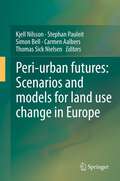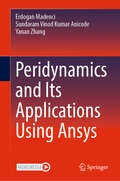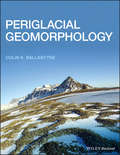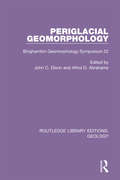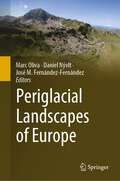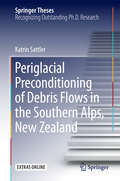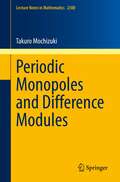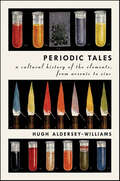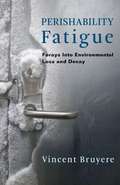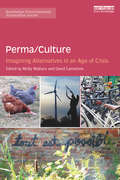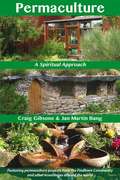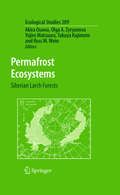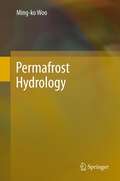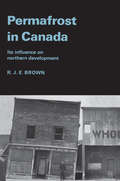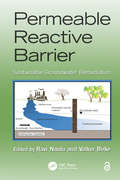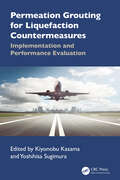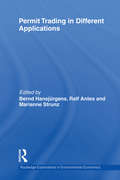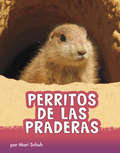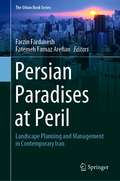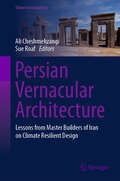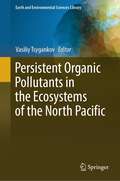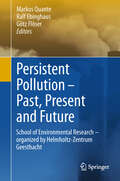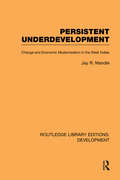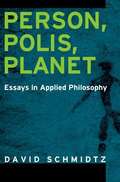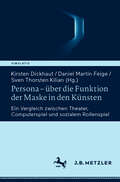- Table View
- List View
Peri-urban futures: Scenarios and models for land use change in Europe
by Simon Bell Kjell Nilsson Stephan Pauleit Carmen Aalbers Thomas A. Sick NielsenPresently, peri-urbanisation is one of the most pervasive processes of land use change in Europe with strong impacts on both the environment and quality of life. It is a matter of great urgency to determine strategies and tools in support of sustainable development. The book synthesizes the results of PLUREL, a large European Commission funded research project (2007-2010). Tools and strategies of PLUREL address main challenges of managing land use in peri-urban areas. These results are presented and illustrated by means of 7 case studies which are at the core of the book. This volume presents a novel, future oriented approach to the planning and management of peri-urban areas with a main focus on scenarios and sustainability impact analysis. The research is unique in that it focuses on the future by linking quantitative scenario modeling and sustainability impact analysis with qualitative and in-depth analysis of regional strategies, as well as including a study at European level with case study work also involving a Chinese case study.
Peridynamics and Its Applications Using Ansys
by Yanan Zhang Erdogan Madenci Sundaram Vinod AnicodeThis book introduces a unified implementation of bond- and state-based peridynamic theory (PD) within a commercial finite element framework, Ansys, utilizing its native elements. It details the implementation of the PD theory and its integration with traditional finite elements. The primary objective is to equip students, researchers, and practicing engineers with both theoretical and practical knowledge of the PD theory, along with the skills necessary for analyzing engineering problems using Ansys. The book demonstrates that, unlike the conventional finite element method (FEM), the PD theory is highly suitable for progressive failure analysis, the multi-scale analysis of materials involving fracture and failure, and multi-physics analysis, including electromigration, corrosion, and electrodeposition. Additionally, it provides a step-by-step illustration of the specific procedures in the pre-processing, solution, and post-processing phases of the analysis through the Graphical User Interface (GUI) for various applications. The book is designed to be introductory and self-contained, minimizing the need for additional reference material.
Periglacial Geomorphology
by Colin K. BallantyneA fascinating and informative exploration of periglacial processes, past and present, and their role in landscape evolution Periglacial Geomorphology presents a comprehensive introduction to the processes that operate in present periglacial environments and discusses the inferences that can be drawn about former periglacial environments from those processes. Organized into six parts, the book opens with the historical and scientific context of periglacial geomorphology and the nature of periglacial environments. Following chapters provide systematic coverage of the full range of topics germane to a thorough understanding of periglacial geomorphology, including: The physics of ground freezing and thawing, characteristics of permafrost, and the nature and origin of underground ice Characteristics, formation and significance of landforms, sediments, and structures associated with permafrost, permafrost degradation, and seasonal ground freezing and thawing Rock weathering in periglacial environments, periglacial processes operating on hillslopes, and the characteristic landforms produced by rock breakdown and slope processes in cold environments The operation of fluvial, aeolian and coastal processes in cold environments, and the resulting distinctive landforms and sediments The use of relict periglacial features to reconstruct past cold environments in midlatitude regions and the responses of periglacial environments to recent and predicted climate change Periglacial Geomorphology is an important resource for undergraduate and graduate students studying geomorphology or Quaternary science within the context of geography and geology degree programs. It will be of use to all scientists whose research involves an understanding of cold environments, whether from a geographical, geological, ecological, climatological, pedological, hydrological, or engineering perspective.
Periglacial Geomorphology: Binghamton Geomorphology Symposium 22 (Routledge Library Editions: Geology #25)
by John C. Dixon Abrahams Athol D.This book, first published in 1992, contains the proceedings of the 22nd Binghamton Geomorphology Symposium, and highlights the quantity and diversity of periglacial geomorphic research being undertaken in Arctic and alpine environments. The articles explore a variety of geomorphic processes and examine the potential impacts of global change on the nature and extent of permafrost and seasonal ice phenomena.
Periglacial Landscapes of Europe
by Marc Oliva Daniel Nývlt José M. Fernández-FernándezThis book comprehensively presents the geography of landforms linked to periglacial processes across Europe. The landscape of the European cold climate regions, both at high latitudes and in mountainous environments, represent the lingering, minimal expression of the glaciers. In addition, periglacial elements can be found in temperate regions, where temperatures no longer favor periglacial processes, so landforms are therefore inherited from previous cold phases.The book is divided into five parts: an introductory section on climate variability responsible for periglacial dynamics across Europe; a second part including 3 blocks on periglacial landforms in southern, central and northern Europe; and a final chapter providing a more general perspective on the impact of periglacial processes on the landscape of Europe. The book offers a valuable reference guide for scientists from all disciplines interested in cold climate processes, as well as readers outside academia (territorial managers, environmentalists, mountaineers, politicians, engineers, etc.).
Periglacial Preconditioning of Debris Flows in the Southern Alps, New Zealand
by Katrin SattlerThis thesis represents one of the few studies so far that systematically analyses environmental conditions within debris flow source areas to determine their relative importance for debris flow development. Environmental site conditions, such as slope gradient and debris availability, influence the spatial and temporal distribution of debris flows in high-alpine areas. However, current understanding of these preconditioning controls is mostly qualitative and inadequate for debris-flow hazard assessments and climate change impact studies. The author's research investigates the role of frost weathering and permafrost in the occurrence of debris flows in the Southern Alps of New Zealand. Analyses are based on an extensive debris flow inventory, documenting debris flow occurrence and activity over the last 60 years in selected catchments. Debris flow activity is compared to frost-weathering intensity estimates from two models, allowing the practical comparison of two competing frost-weathering hypotheses currently discussed in literature. Information on permafrost occurrence is based on a new distributed permafrost estimate for the Southern Alps, derived from climatic conditions at active rock glacier sites. This pioneering thesis provides empirical evidence that frost weathering promotes debris-flow formation. It further highlights the potential and limitations of regional-scale studies for advancing our understanding of debris-flow preconditioning factors.
Periodic Monopoles and Difference Modules (Lecture Notes in Mathematics #2300)
by Takuro MochizukiThis book studies a class of monopoles defined by certain mild conditions, called periodic monopoles of generalized Cherkis–Kapustin (GCK) type. It presents a classification of the latter in terms of difference modules with parabolic structure, revealing a kind of Kobayashi–Hitchin correspondence between differential geometric objects and algebraic objects. It also clarifies the asymptotic behaviour of these monopoles around infinity.The theory of periodic monopoles of GCK type has applications to Yang–Mills theory in differential geometry and to the study of difference modules in dynamical algebraic geometry. A complete account of the theory is given, including major generalizations of results due to Charbonneau, Cherkis, Hurtubise, Kapustin, and others, and a new and original generalization of the nonabelian Hodge correspondence first studied by Corlette, Donaldson, Hitchin and Simpson.This work will be of interest to graduate students and researchers in differential and algebraic geometry, as well as in mathematical physics.
Periodic Tales: A Cultural History of the Elements, from Arsenic to Zinc
by Hugh Aldersey-WilliamsIn the spirit of A Short History of Nearly Everything comes Periodic Tales. Award-winning science writer Hugh Andersey-Williams offers readers a captivating look at the elements—and the amazing, little-known stories behind their discoveries. Periodic Tales is an energetic and wide-ranging book of innovations and innovators, of superstition and science and the myriad ways the chemical elements are woven into our culture, history, and language. It will delight readers of Genome, Einstein’s Dreams, Longitude, and The Age of Wonder.
Perishability Fatigue: Forays Into Environmental Loss and Decay (Critical Life Studies)
by Vincent BruyereThe Svalbard Global Seed Vault project is an arctic archive designed to preserve the world’s agricultural biodiversity. What do it and other novel forms of storage tell us about our relationship to the future in a time of resource depletion and extinction scenarios? In this innovative book, Vincent Bruyere offers an invitation to look at the present we live in through a fresh lens: the difference between storage and burial in the age of sustainability science.Perishability Fatigue considers questions of permanence and the potentiality of retrieval, noting the tensions within our collective sense of time and finitude. Bruyere reflects on the nature and significance of perishability, asking what it means to have one’s sense of temporality engendered by seed banks and frozen embryo storage, genetically modified organisms and the “de-extinction” of species, nuclear-waste repositories, oncology, and palliative care. He draws attention to the scripts and scenarios that mediate our relations to loss and decay, preservation and conservation, emphasizing the inequalities implicit in technologies of perishability, which promise continuity in the future to some while refusing it to others. A highly interdisciplinary study, Perishability Fatigue reframes the environmental humanities and humanistic inquiry into sustainability science by developing a new language to commemorate fatigue and transience in a culture of preparedness and survival.
Perma/Culture: Imagining Alternatives in an Age of Crisis (Routledge Environmental Humanities)
by Molly Wallace and David CarruthersIn the face of what seems like a concerted effort to destroy the only planet that can sustain us, critique is an important tool. It is in this vein that most scholars have approached environmental crisis. While there are numerous texts that chronicle contemporary issues in environmental ills, there are relatively few that explore the possibilities and practices which work to avoid collapse and build alternatives. The keyword of this book’s full title, 'Perma/Culture,' alludes to and plays on 'permaculture', an international movement that can provide a framework for navigating the multiple 'other worlds' within a broader environmental ethic. This edited collection brings together essays from an international team of scholars, activists and artists in order to provide a critical introduction to the ethico-political and cultural elements around the concept of ‘Perma/Culture’. These multidisciplinary essays include a varied landscape of sites and practices, from readings from ecotopian literature to an analysis of the intersection of agriculture and art; from an account of the rewards and difficulties of building community in Transition Towns to a description of the ad hoc infrastructure of a fracking protest camp. Offering a number of constructive models in response to current global environmental challenges, this book makes a significant contribution to current eco-literature and will be of great interest to students and researchers in Environmental Humanities, Environmental Studies, Sociology and Communication Studies.
Permaculture: A Spiritual Approach
by Craig Gibsone Jan Martin BangPermaculture design as divine creative activity. Permaculture looks for the patterns embedded in our natural world as inspirations for designing solutions to the many challenges we are presented with today. It is a philosophical, spiritual and practical approach to the use of the land, integrating microclimate, functional plants, animals, soils, water management and human needs into intricately connected, highly productive systems. In essence, permaculture uses observation as basis for creating sustainable and effective human settlements. The authors discuss the components Earthshare, Fairshare and Peoplecare, with a specific emphasis on the spiritual aspects of the design process. Topics range from soil and plants, energy sources and house design to alternative economics, group process, governance, and spiritual nurturing and enquiry. Examples of existing permaculture structures from around the world, most notably from the Findhorn Community Eco-Village, bring the concepts to life. First-hand accounts of how people got started on their permaculture project lend a personal touch. The first book to look at the spiritual aspects as well as the practical implementation of permaculture design.
Permafrost Ecosystems
by Akira Osawa Olga A. Zyryanova Takuya Kajimoto Yojiro Matsuura Ross W. WeinDrawing from a decade-long collaboration between Japan and Russia, this important volume presents the first major synthesis of current knowledge on the ecophysiology of the coniferous forests growing on permafrost at high latitudes. It presents ecological data for a region long inaccessible to most scientists, and raises important questions about the global carbon balance as these systems are affected by the changing climate. Making up around 20% of the entire boreal forests of the northern hemisphere, these 'permafrost forest ecosystems' are subject to particular constraints in terms of temperature, nutrient availability, and root space, creating exceptional ecosystem characteristics not known elsewhere. This authoritative text explores their diversity, structure, dynamics and physiology. It provides a comparison of these forests in relation to boreal forests elsewhere, and concludes with an assessment of the potential responses of this unique biome to climate change. The book will be invaluable to advanced students and researchers interested in boreal vegetation, forest ecology, silviculture and forest soils, as well as to researchers into climate change and the global carbon balance.
Permafrost Hydrology
by Ming-Ko WooPermafrost Hydrology systematically elucidates the roles of seasonally and perennially frozen ground on the distribution, storage and flow of water. Cold regions of the World are subject to mounting development which significantly affects the physical environment. Climate change, natural or human-induced, reinforces the impacts. Knowledge of surface and ground water processes operating in permafrost terrain is fundamental to planning, management and conservation. This book is an indispensable reference for libraries and researchers, an information source for practitioners, and a valuable text for training the next generations of cold region scientists and engineers.
Permafrost in Canada
by Roger J.E. BrownPermafrost is the thermal condition of the earth's crust when its temperature has been below 32°F continuously for a number of years. Half of Canada's land surface lies in the permafrost region--either in the continuous zone where the ground is frozen to a depth of hundreds of feet, or in the discontinuous zone where permafrost is thinner, and there are areas of unfrozen ground.The existence of permafrost causes problems for the development of the northern regions of all countries extending into the Arctic. Mining operations are hindered by frozen ore which resists blasting and is difficult to thaw. Agriculture is restricted by the presence of permafrost near the ground surface which limits the soil available for plant growth. Engineering structures are also affected by the low temperatures. Ice layers give soil a rock-like structure with high strength. However heat transmitted by buildings often causes the ice to melt, and the resulting slurry is unable to support the structure. Many settlements in northern Canada have examples of structural damage or failure caused by permafrost. In the construction and maintenance of railways, buildings, water and sewage lines, dams, roads, bridges, and airfields, normal techniques must often be modified at additional cost because of permafrost.For the last twenty-five years scientific investigations and engineering projects have increased steadily in Canada's permafrost region, and it is now technically possible to build any structure or conduct any activity on the worst soils and under permafrost conditions.This comprehensive analysis of permafrost--its origin, definition, and occurrence, and the effect it has on industry and agriculture--will be invaluable to the growing number of people working in the north and to those interested in its development.
Permeable Reactive Barrier: Sustainable Groundwater Remediation (Advances in Trace Elements in the Environment #1)
by Ravi NaiduRemediation of groundwater is complex and often challenging. But the cost of pump and treat technology, coupled with the dismal results achieved, has paved the way for newer, better technologies to be developed. Among these techniques is permeable reactive barrier (PRB) technology, which allows groundwater to pass through a buried porous barrier that either captures the contaminants or breaks them down. And although this approach is gaining popularity, there are few references available on the subject. Until now. Permeable Reactive Barrier: Sustainable Groundwater Remediation brings together the information required to plan, design/model, and apply a successful, cost-effective, and sustainable PRB technology. With contributions from pioneers in this area, the book covers state-of-the-art information on PRB technology. It details design criteria, predictive modeling, and application to contaminants beyond petroleum hydrocarbons, including inorganics and radionuclides. The text also examines implementation stages such as the initial feasibility assessment, laboratory treatability studies (including column studies), estimation of PRB design parameters, and development of a long-term monitoring network for the performance evaluation of the barrier. It also outlines the predictive tools required for life cycle analysis and cost/performance assessment. A review of current PRB technology and its applications, this book includes case studies that exemplify the concepts discussed. It helps you determine when to recommend PRB, what information is needed from the site investigation to design it, and what regulatory validation is required.
Permeation Grouting for Liquefaction Countermeasures: Implementation and Performance Evaluation
by Yoshihisa Sugimura Kiyonobu KasamaAcademic and industry experts describe the use of chemical (permeation) grouting beneath an airport runway to improve ground resistance to liquefaction. They present the cost, environmental, and operational benefits; specifications; methodology; and practical results of this cutting-edge method. Because transportation infrastructure such as ports and airports are required to operate even in the event of a large earthquake, they must be resilient against liquefaction.Through contributions from experts in academia and industry, this book describes the discovery of construction defects at three airports in Japan and the subsequent project to repair and strengthen the ground using chemical grouting using environmentally friendly colloidal silica, the first time this technique was used in Japan. This book first describes chemical grouting and its benefits, its specifications, and field investigation results of its ground improvement performance. Next, it demonstrates a numerical and probabilistic method to model spatial variability in material properties of field data on improved ground. Finally, it explains a performance-based verification for airport runway availability in terms of bearing capacity and runway flatness after a large earthquake. Through its clear explanations, this book enables readers to implement chemical grouting and enjoy the cost, environmental, access, and operational benefits of this technique over traditional methodologies that would require temporary site closure and large-scale excavation. Because the concept and methodology described in this book are applicable to various geological, geotechnical, and seismological conditions depending on the location and structural and operational conditions depending on the infrastructure type, this book is a useful resource for geotechnical and other infrastructure engineers who must strengthen the ground without disrupting normal operations.
Permit Trading in Different Applications (Routledge Explorations In Environmental Economics #33)
by Bernd Hansjürgens Ralf Antes Marianne StrunzPermit trading is an environmental policy instrument that has received increasing levels of attention over recent years. Coming from the field of air quality management, with the European CO2 emissions trading system being the most prominent example, it enters new fields of application, such as land use policy and biodiversity protection, water quality and water quantity trading. This book gives an overview of these recent developments and discusses the possibilities and limits of permit trading in environmental policies. The advantages of permit trading are not only seen with respect to economic efficiency, which leads to achieving the environmental target at minimum cost, but also with respect to the instrument’s environmental effectiveness. By setting a cap for the overall emissions, a given environmental target can be met. This makes permit trading an interesting case for many environmental fields where safeguarding the environmental target plays a dominant role. Against this background, permit trading is discussed in environmental policy fields, where it has not been considered before, for example, land use management, biodiversity protection and water trading. Permit Trading in Different Applications analyses the properties of permit trading: its possibilities and limitations, its design options and its restrictions on a more general level. It demonstrates how lessons learnt in established policy fields like air quality management can be transferred to new and emerging fields of application. This collection will provide students and practitioners in environmental sciences and policy with valuable research into instrument choice and design with respect to permit trading.
Perritos de las praderas (Animals en espanol)
by Mari Schuh¿Alguna vez has visto un agujero en la tierra y te has preguntado que´ hay dentro? ¡Podri´a ser un perrito de las praderas! Estos pequen~os y tiernos mami´feros construyen comunidades de tu´neles subterra´neos. Descubre fascinantes datos sobre los perritos de las praderas y ente´rate de lo que realmente ocurre bajo tierra.
Persian Paradises at Peril: Landscape Planning and Management in Contemporary Iran (The Urban Book Series)
by Fatemeh Farnaz Arefian Farzin FardaneshThis book offers a resourceful collection of essays examining recent efforts to respond to the challenges of planning, management and conserving landscapes in contemporary Iran, the home of Persian gardens. Drawing on selected recent studies, the chapters discuss the following topics: The sphere of knowledge and theoretical bases, including a survey of recent and ongoing research;Persian gardens remaining from the 6th century BC to the 19th century AD, which have influenced garden design in a vast geographic domain extending from India to Spain;Management and conservation of cultural landscapes, historic urban landscapes (HUL), road landscapes, and natural landscapes in the face of changes in climatic conditions and livelihood practices affecting their delicate dynamic balance and functions essential to their distinctive character; and Historic Territorial Landscapes (HTL) formed and evolved along the Silk and Spice Roads as compositions of tangible and intangible elements resulting from movement, exchanges and dialogue in space and over time.The book is a useful resource for a range of academics and professionals, such as landscape architects and managers, landscape historians and conservationists, and urban planners and managers.
Persian Vernacular Architecture: Lessons from Master Builders of Iran on Climate Resilient Design (Urban Sustainability)
by Ali Cheshmehzangi Sue RoafThis timely book aims to address a significant challenge in contemporary design and architecture, i.e., “to learn from the vernacular”. Vernacular architecture refers to traditional and indigenous building styles that have evolved in response to local climate, materials, and cultural practices. These styles often embody 'extreme' design principles, as they support life without relying on modern mechanical systems for heating and cooling. The core premise of the book is that these time-tested design solutions offer valuable lessons for real sustainable and climate-resilient architecture today. We strongly urge a return to the vernacular as a source of inspiration and knowledge. Hence, a genuine dedication to dedicated Ostads or master builders of Iran, who have contributed extensively to making and co-creating climate-resilient architecture and climate-sensitive design. This is more than just a box-ticking sustainability exercise and delves more deeply into the building performance and its impact on our everyday life, our health and wellbeing, and us as human beings. The book posits that contemporary architects and designers can learn valuable lessons by studying the adaptive strategies and sustainable practices embedded in the traditional vernacular architecture of Iran. These lessons are crucial for addressing modern challenges such as climate change, resource scarcity, and the need for energy-efficient buildings. By revisiting and analysing vernacular architecture, the book aims to bridge the gap between traditional knowledge and contemporary design practices. It provides a comprehensive exploration of how vernacular principles can be integrated into modern architectural education and practice. The goal is not only to preserve traditional wisdom but also to innovate upon it, creating buildings that are both culturally relevant and environmentally sustainable. The contributing case study chapters of the book include an excellent range of practical recommendations for architects, researchers, and policymakers. By fostering a deeper understanding of vernacular architecture, the book seeks to inspire a new generation of architects to create buildings that are harmonious with their environment and resilient to future challenges. Through this approach, we believe lessons from vernacular buildings ought to offer the promise of reintegrating real Resilience into the design of the next generation of buildings.
Persistent Organic Pollutants in the Ecosystems of the North Pacific (Earth and Environmental Sciences Library)
by Vasiliy TsygankovThe book reports the results on the fate of POPs in the abiotic and biotic components of the aquatic environment North Pacific Ocean (include Russian part of North Pacific), possible health risks for coastal residents Pacific Ocean exposed to these hazardous pollutants are systematized. In particular, indicator organisms (fish, birds, and mammals), indicating the pollution of the region, were identified; the possible ways of xenobiotic transfer from the sea to the land are shown; the targets of POPs impact on living organisms were determined; the time of circulation of pollutants in the biosphere was determined; a list of “priority” toxicants for the region based on quality screening was compiled; the risks to human health from the consumption of contaminated aquatic organisms were assessed; the levels of POPs in the human body were measured. The book is interesting for specialists in the agro-industrial complex, aquaculture and medicine, teachers and graduate students of universities, researchers, which interested in the problems of persistent organic pollutants (POPs). There are no similar books on the study of POPs in the Russian part of the Pacific Ocean in the world literature. This book is useful to scientists of the world who study the fate of POPs.
Persistent Pollution – Past, Present and Future
by Götz Flöser Markus Quante Ralf EbinghausThis book evolved from the 5th School of Environmental Research entitled "Persistent Pollution - Past, Present and Future", which has set a focus on Persistent Organic Pollutants (POPs), heavy metals and aerosols. - reconstruction of past changes based on the scientific analysis of natural archives such as ice cores and peat deposits,- evaluation of the present environmental state by the integration of measurements and modelling and the establishment of cause-effect-patterns,- assessment of possible environmental future scenarios including emission and climate change perspectives.
Persistent Underdevelopment: Change and Economic Modernization in the West Indies (Routledge Library Editions: Development)
by Jay MandleFirst published in 1996, this insightful and informative text examines the post-emancipation and recent economic history of the Commonwealth Caribbean. Jay R. Mandle offers an explanation of the region’s continuing underdevelopment. Through the use of an analytical framework derived from the works of Marx and Kuznets, the book focuses attention on technological change as the driving force behind economic modernization. Persistent Underdevelopment begins by exploring how plantation agriculture had a limiting effect on industrial growth. Ultimately, plantation dominance receded; technological stagnation continued, however, and, under British colonial policy the Caribbean failed to modernise. The post-World War II era brought new efforts at modernisation through the economic policies of the left regimes of Manley, Burnham and Bishop. The concluding chapters point the way to policies that would enable the Caribbean to escape its current poverty and become an effective participant in world markets, finally achieving the goal of modern economic development.
Person, Polis, Planet: Essays in Applied Philosophy
by David Schmidtz<p>This volume collects thirteen of David Schmidtz's essays on the question of what it takes to live a good life, given that we live in a social and natural world. Part One defends a non-maximizing conception of rational choice, explains how even ultimate goals can be rationally chosen, defends the rationality of concern and regard for others (even to the point of being willing to die for a cause), and explains why decision theory is necessarily incomplete as a tool for addressing such issues. <p>Part Two uses the tools of analytic philosophy to explain what we can do to be deserving ,what is wrong with the idea that we ought to do as much good as we can, why mutual aid is good, but why the welfare state does not work as a way of institutionalizing mutual aid, and why transferring wealth from those who need it less to those who need it more can be a bad idea even from a utilitarian perspective. Most ambitiously, Part Two offers an overarching, pluralistic moral theory that defines the nature and limits of our obligations to each other and to our individual selves. <p>Part Three discusses the history and economic logic of alternative property institutions, both private and communal, and explains why economic logic is an indispensable tool in the field of environmental conflict resolution. In the final essay, Schmidtz brings the volume full circle by considering the nature and limits of our obligations to nonhuman species, and how the status of nonhuman species ought to enter into our deliberations about what sort of life is worth living.</p>
Persona – über die Funktion der Maske in den Künsten: Ein Vergleich zwischen Theater, Computerspiel und sozialem Rollenspiel (Simulatio. Theatertechniken in Literatur, Medien und Wissenschaft)
by Daniel Martin Feige Kirsten Dickhaut Sven Thorsten KilianDer Sammelband thematisiert Masken und Maskierungen. Im Vergleich der Künste untersucht er die funktionale Verwendung dieses Theaterrequisits, das eine Technik impliziert, und die Ausgestaltungen von Persona in den Künsten, Maskenverwendungen, -gestaltungen und -problematisierungen, die stets die Produktion von Fiktion und/oder Simulation reflektieren. Zehn Beiträge analysieren Beispiele seit dem 18. Jahrhundert der bildenden Kunst, des Digitalen, des Computerspiels, des Theaters, der erzählenden Literatur und der sozialen Rolle, die jeweils die Maske als Fiktions- oder Simulationsgenerator verstehen, thematisieren und kulturell vergleichend beschreiben. Pirandello stellt dabei grundsätzlich einen wichtigen, aber nicht den einzigen Referenzpunkt dar.
